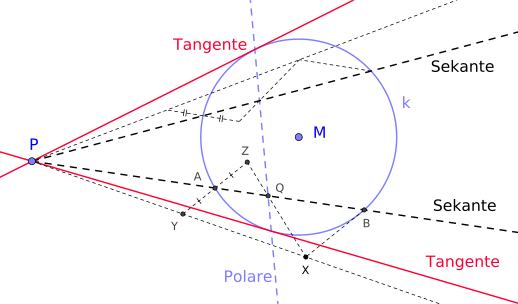Circle tangent
The tangent of a circle is any straight line runningin the same plane that hasexactly one point in commonwith the circle .
The straight lines running in the circular plane can be divided into secants , tangents and passers-by . In a certain way, the tangents represent the borderline case between secants and passers-by.
One of the basic properties of the tangent is that it runs orthogonally (at a right angle ) to its radius of contact , i.e. to the line connecting the point of contact and the center of the circle. Conversely, every straight line that is perpendicular to the end point of a radius is also a tangent of the circle. This is due to the fact that the straight line to which the radius belongs (like every straight line through the center point) is the axis of symmetry of the circle.
Construction of the tangent
For a construction with compass and ruler it is by no means sufficient to find a straight line by eye that “just barely” touches the circle k .
- If the contact point is given (or can be chosen as desired), the contact radius must first be drawn and then the plumb line for it at the contact point.
- If there is a point P outside the circle through which the tangent is to go, the point of contact must first be found. Since a right angle has to be created, the Thales theorem helps :
Connect point P with circle center M and draw the Thales circle over the line [ PM ]. This intersects the circle k in two points that are suitable as contact points. So we get two possible circle tangents through the point P. The straight line determined by the two points of contact is called the polar of the point P with respect to the circle k .
- An alternative to the construction using the Thales group is to design directly on the point P belonging to Polar . For this purpose, one draws any two secants starting from P and then divides the chords they create harmoniously, whereby the point P is the outer point of division of the harmonic division of the chord. The two inner dividing points of the tendons then lie on the polar to P and the polar intersects the circle at the two points of contact of the tangents to be constructed. The inner division point of the harmonic division of a tendon can be constructed as follows. It is characterized by an arbitrary P -extending auxiliary line and selects on that one (any) of P different point X . Then draw the straight connecting line between X and the rear end point B of the chord and then draw a parallel to this line through the front end point A of the chord. This parallel intersects the original auxiliary straight line at a point Y and a segment of length | AY | is now on the other side of A , and whose end point links Z with X . The segment ZX then intersects the chord AB at point Q , which is the inner division point of the harmonic division of AB . That is, P and Q share the chord AB harmoniously and Q lies on the polar belonging to P. This construction with the help of the polar can also be applied to other conic sections, that is, one can also construct tangents to ellipses, parabolas and hyperbolas in this way.
Analytical geometry
Is a circle with radius and center given by the equation
- or ,
and is the contact point ,
this is the equation of the tangent
or.
( ) stands for any point on the tangent.
See also
Tangent , tangent square , secant-tangent set , tangent
literature
- David Fraivert: Properties of the tangents to a circle that forms Pascal points on the sides of a convex quadrilateral. . Forum Geometricorum, Volume 17, 2017, pp. 223–243.











